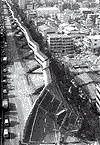
|
 |
Unpredictable Dangers |
| Story by Yuthawong Wongthong |
|
 |
|
Our present understanding
of the earth and its crust is based on theories formed less than a century ago. Alfred
Wegener, a German meteorologist, introduced the idea of the continental drift in 1912,
explaining how each continent showed evidence of having once fitted together forming one
huge continent. During the next 50 years, more hypotheses were made and tested which
developed into the now generally accepted plate tectonic theory.
According to the theory, the surface of the earth actually comprises of
several pieces or plates moving at an average rate of an inch per year (about the rate our
fingernails grow). As they do their edges collide or rub against each other resulting in
transformation of the earth's surface (like the spreading of the sea floor, the formation
of mountain ranges) and frequent natural disasters (like the tsunami and earthquakes).
|
 |
|
Thailand has had its share
of earthquake activity. Southeast Asia is the southern most part of the Eurasian Plate and
Thailand itself, though a fairly safe distance from the plate boundary, has about nine
active faults of its own which can erupt in minor quakes.
The exciting discovery that Thailand is not one land but a joining of
the Shan-Thai and the Indochina plates with a foldbelt running from Nan to Chanthaburi
where the plates meet only serves to remind us that the 1997 law concerning construction
in risk areas is important and appropriate. But other risks we are taking with the
staggering number of gas pipelines and dams that lie on active faults with no safety
precaution may result in a hard and disastrous lesson some day.
|
| |
|
|
|